
Cyber-physical systems and the supply chain
Industry 4.0 has ushered in advancements such as cyber-physical systems to enable communication between physical objects over the internet.
What are cyber-physical systems?
Cyber-physical systems (CPSs) are mechanisms built from the seamless integration between computing and physical components, all driven by algorithms. They have the ability to replicate, automate and control physical elements in a digital environment. According to the US National Science Foundation, they integrate computation, control and networks into physical objects and infrastructures, connecting them to the internet and each other.
While cyber-physical systems are quite similar to the Internet of Things (IoT) or the Industrial IoT, they’re not the same. As indicated by Vanderbilt University, IoT is the technology that enables the interconnection of devices used to monitor and exchange data. Cyber-physical systems, meanwhile, are closely tied to physical processes. They form the foundation for an IoT that, in turn, can optimise efficiency and connectivity for devices and services across multiple areas of the cyber-physical space.
Characteristics of cyber-physical systems
CPSs and robotics are often interconnected, as this technology can be applied to nanodevices and robots in manufacturing precision mechanisms:
- Data-driven. Cyber-physical systems collect information from sensors and IoT devices.
- Mobile sensors for data fusion. First, small mobile sensors are integrated into physical objects. Then, data gathered from various points across the network are combined to create new information, enriched with context and insights from all sources.
- Model trainers. Once the data are contextualised, cyber-physical systems can be used to train artificial intelligence (AI) models.
- Simulation-based designs. CPSs are designed based on extensive simulations, providing real-time feedback on physical characteristics.
- Autonomous. Cyber-physical systems hardware and software are intelligent, precise and reactive. They can account for physical system behaviour without manual supervision or human intervention.
- Real-time communication. IoT sensors and other networked devices continuously collect information and can analyse experiences. This allows them to implement improvements, apply them and boost their efficiency.
- Secure and private. Cyber-physical systems can incorporate mechanisms to mask user identities and anonymise data before using them to model and control any of their physical design characteristics.

What do cyber-physical systems consist of?
In these application-controlled systems, sensors serve as the gateway for AI algorithms running in the cloud. These elements make up cyber-physical systems and enable them to function in a cyber-physical space:
- Hardware. Sensors and electrical, electronic, hydraulic, mechanical, mechatronic and pneumatic systems.
- Software. Algorithms that make intelligent decisions based on the information collected.
- Connectivity components. These establish communication with other systems to generate and exchange useful data.
Examples of cyber-physical systems
Integrating computing, data storage and communication capabilities with the control of physical objects makes it possible to develop new solutions in scenarios such as these:
- Machine control for improved performance.
- System monitoring and optimisation through predictive maintenance.
- Collaboration and learning among robots. Cyber-physical systems and robotics coexist when, for example, autonomous mobile robots (AMRs) share warehouse maps with each other via fleet management software.
- Vehicles that distribute information with infrastructures or with each other to choose the optimal route or speed.

Differences between cyber-physical systems and the IoT
Cyber-physical systems provide feedback control of the physical world through real-time computing. Several other characteristics differentiate CPSs from the IoT:
| Cyber-physical systems | Internet of Things |
|---|---|
| monitor and control physical processes. | creates a network of interconnected devices that collect and exchange data. |
| integrate physical components with networked digital technology. | contains physical devices connected to sensors over the internet. |
| are more complex than IoT devices. | incorporates relatively simple devices. |
| are designed to interact with and manage physical processes. | contains devices created to interact with data centres. |
| require real-time data analysis to ensure that physical systems are functioning correctly. | generates large amounts of information that can be analysed to gain insights into user behaviour, products and other factors. |
| comprise autonomous vehicles, industrial automation systems and medical devices. | can be employed by smart thermostats, fitness trackers and home security systems. |
Application areas of cyber-physical systems
With continuous data feedback, cyber-physical systems become increasingly data-rich. This makes them valuable in various industrial sectors and supply chain applications:
- Smart factories. These workplaces leverage CPSs to control production processes and monitor energy consumption. Cyber-physical systems and robotics work hand in hand.
- Medical technology. Examples include bionic prosthetics and medical instruments used in surgeries.
- Autonomous vehicles, drones and smart homes.
Improve your warehouse performance with Mecalux
Are you looking to optimise your logistics facilities and make the most of your investment? At Mecalux, we’re here to help. As automation experts, we’ve developed Easy WMS, a warehouse management system designed to enhance your operations. We also offer Easy DOM, an advanced order management system for companies with multiple distribution centres. Be sure to contact us for advice on this and other storage solutions.
